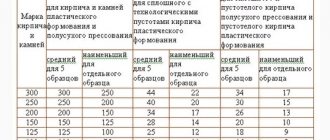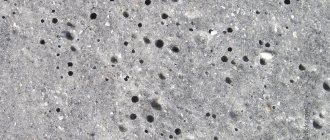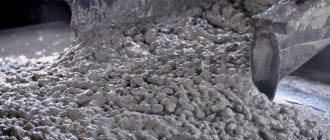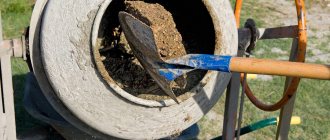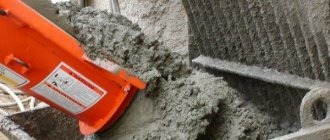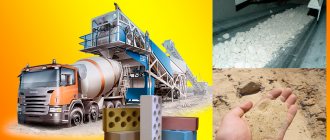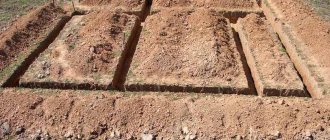Frost resistance of concrete is one of the most important characteristics for construction in latitudes where frequent and significant temperature changes are observed. More precisely, the frost resistance of concrete is the ability to go through several cycles of freezing and thawing without significant damage or deformation of the internal structure of the concrete structure. In this case, a threshold of loss of strength characteristics of up to 5% must be observed. That is, if concrete loses more than 5% of its strength after freezing and thawing, this is considered a violation of the technology.
To indicate frost resistance characteristics, the symbol “f” and a numerical designation from 50 to 1000 are used, which directly indicates the number of permissible freezing and thawing cycles without loss of strength characteristics. For example, frost resistance f50 is an indicator indicating that concrete can go through 50 freezing cycles without obvious loss of strength. There are also more resistant concretes with frost resistance f150, 200, 300, etc.
In this material, we will talk about such a property of concrete as frost resistance. We'll tell you how to determine the frost resistance of concrete. Let us dwell in detail on the classes of concrete taking into account this characteristic, as well as the methods available today to increase it. First things first.
Classification of frost resistance of concrete
Types of concrete mixtures for frost resistance are regulated by GOST 25192-2012. In addition to the F index, frost resistance can be determined by the following characteristics:
- F1 – grade established during the study of material in a water-saturated state;
- F2 is a brand of concrete mixtures produced for the construction of road and airfield pavements or operation in contact with mineralized waters; samples for research are saturated with a 5% NaCl solution.
Requirements for the frost resistance of concrete depend on the planned area of its application:
- Up to F50 . This is a low level of resistance to alternating temperatures. This mixture is used for interior work and in preparatory construction activities.
- F50- F150 . This material with an average level of frost resistance is widely used in ordinary construction of facilities located in regions with a temperate, stable climate.
- F150- F300 . Such concretes are in demand for construction in regions with cold climates.
- Above F300 . Mixtures with high resistance to temperature changes are used for the construction of special-purpose facilities, as well as structures operated in harsh climatic conditions.
The strength and frost resistance of all types of concrete are directly related: the higher the strength, the greater the frost resistance of the material.
Table of dependence of strength class and frost resistance of concrete
| Concrete grade | Strength class | Frost resistance class | Waterproof class |
| 100 | B7.5 | F50 | W2 |
| 150 | B10-B12.5 | ||
| 200 | B15 | F100 | W4 |
| 250 | IN 20 | ||
| 300 | B22.5 | F200 | W6 |
| 350 | B25 | W8 | |
| 400 | B30 | F300 | W10 |
| 450-600 | B35-B45 | W8-W18 |
This is interesting: Do-it-yourself concrete floor on the ground in a house
Construction from aerated blocks in winter
As a rule, experts recommend carrying out construction work in the warm season. However, many developers are in a hurry to move into a new house and are wondering whether it is possible to build buildings from aerated concrete in the winter, as is done with brick, cinder blocks and other materials. This is not an idle question - the opportunity to save at least six months greatly attracts users.
There is no clear answer to this. Most experts do not recommend building in winter, since aerated concrete has poor contact with adhesives in winter. At the same time, everything depends on specific climatic conditions - there are regions where temperatures rarely drop even to -5°, but for most areas the average winter temperature is -10° or -15°. Water from adhesive solutions penetrates into the material and freezes, forming a local area with a problematic temperature regime. At the same time, the adhesive composition also hardens, which makes high-quality adhesion to gas blocks problematic.
There are special winter compounds designed for work at temperatures from -15°. However, practical experience shows that it is inappropriate to carry out work even at -10°. In addition, you will have to warm up the gas blocks using heat guns and remove ice on the surface of the masonry rows. These procedures require time and effort, as well as considerable expenses. Therefore, experts recommend not to risk the strength of the house and build in the warm season.
Frost resistance of bricks: brands, what it depends on
In the construction of a brick structure, the frost resistance of the brick is not the main, but significant factor influencing its choice, especially if it is used for laying external walls. Weather conditions are constantly changing, the temperature regime is not stable, which most exposes brick buildings to the risk of accelerated wear, cracks and a decrease in their service life.
Why is frost resistance important for brick?
The concept of frost resistance refers to the ability of a substance or material to withstand defrosting/freezing cycles without loss of properties: structural damage, deterioration of strength and the appearance of visible external damage. The fact that frost does not destroy dry bricks is taken into account. The structure of the material contains porous formations into which water enters, freezing during frost and destroying the stone, since in the ice state it occupies a larger volume than in the form of a liquid.
The frost resistance grade is designated by the letter F and a number. According to GOST construction standards, the following grades are distinguished: F15, 25, 35, 50, 75, 100, 200, 300. Frost resistance can only be correctly determined by testing in laboratory conditions. The technique is step-by-step and consists in the fact that the sample is first kept for 8-9 hours in cold water, and then placed in a refrigerator at a temperature of -20 degrees. At the end of each stage, the material under study is checked for the appearance of external changes. Thus, a sample labeled F50 means that this species can withstand 50 freeze/thaw cycles without deformation.
What does it depend on?
The frost resistance of a material is influenced by 2 factors:
- chemical composition;
- shape and size.
Material composition
The degree of resistance of a material to cold depends on the quality of the sand and clay in its composition.
Manufacturing technology is the first thing that affects the quality of the material. Companies producing building materials use equipment that changes production technology. In creating bricks, special dispersed additives are used that prevent the liquid from hardening. The second factor is the quality of raw materials. The better the clay and sand, the higher the resistance index: a sample made of kaolin clay is considered non-frost-resistant, and material containing a high content of quartz and calcium silicates has a frost resistance level 40% higher than ordinary.
Sizes and shape of bricks
The standard material size is 25x12x6.5 - this is single. To speed up construction, one-and-a-half and double versions are made, which are 30-40% higher than the ordinary one. The concept of the shape or size of a brick refers to its fullness or porosity. The more holes and pores the finished material has, the less frost-resistant it is.
Laboratory tests have proven that the frost resistance of sand-lime brick is 2-3 times higher than that of ceramic brick.
Material grades
Depending on the strength, the material is assigned a specific grade.
The main property of each type of brick is strength. This concept assumes that there is no destruction of the material structure and deformation under load and internal/external influences of various natures. According to construction standards, this parameter is designated by the letter M and the corresponding number, which measures the load withstood by the sample per 1 cm². GOST established 8 strength grades: M-75,100, 125, 150, 175, 200, 250, 300.
Types of bricks and their frost resistance
Factories produce 15 varieties of material, each with certain characteristics, but the following are most often used:
- Full-bodied. This is an ordinary building brick, which is characterized by low porosity, in contrast to hollow brick. Samples marked M200-300 are used to create heavy structures and poles. Solid brick is characterized by frost resistance F50-75, which allows its use in various branches of construction. For external walls, it is necessary to lay brick in 2 layers and insulate it.
- Hollow. Its distinctive feature is the increased number of holes in the structure. The shape of the voids varies from cylindrical to oval and rectangular. It has a high ability to conduct and retain heat, but is used for lightweight structures, cladding and interior partitions. The frost resistance of hollow bricks varies from F15 to F50.
- Silicate. Made from lime and impurities, it costs less than ceramic. It is not resistant to moisture, but this can be removed with waterproofing. Its frost resistance is from 15 to 50 cycles.
- Facade. Facing bricks are used to lay out the front parts of buildings: it conducts heat poorly, but it is resistant to sub-zero temperatures. The frost resistance of this sample is from 25 to 75 cycles and the cost is much higher than that of ceramic bricks.
For cladding the facades of large buildings, laying roads and streets, clinker stone is used, the strength of which reaches the value of M-1000. This material is characterized by the best frost resistance among all types and can withstand up to 100 cycles. To create furnaces, fireproof and fireclay bricks are used, which do not collapse under the influence of high temperatures. Their frost resistance is F15 - F50. When choosing a material, it is advisable to focus on weather conditions: if there are no severe frosts in the area, reaching 40 degrees, it is not advisable to choose too stable options and overpay extra money.
What is aerated concrete, its technical characteristics
The family of cellular concrete includes several materials, among which aerated concrete is the leader in terms of the combination of parameters. It has a porous structure that determines almost all technical characteristics. Among them, the most important are:
- density. It is determined by the grade of the material - for example, aerated concrete blocks of the D500 brand have a conditional density of 500 kg/m3;
- compressive strength. This indicator determines the strength class. It is designated by Latin B. If the material marking indicates B2.5, it means that the block is capable of withstanding a pressure of 2.5 Newton per mm2;
- thermal conductivity. It determines the ability of walls to retain thermal energy and save on heating. On average, for dry material this figure is 0.13 W/m°C;
- frost resistance. This is an indicator that determines how many freezing cycles a material can withstand without losing its working qualities.
The parameters of aerated concrete may vary - products from different manufacturers have some deviations in indicators in one direction or another. They are determined by technological conditions, the presence of additives, and other factors. Few brands have the most balanced characteristics, for example, the YTONG company.
Advantages and disadvantages of aerated concrete
The advantages of the material include:
- light weight, reducing the load on supporting structures and reducing the power of the foundation;
- low thermal conductivity, the ability to accumulate thermal energy, which saves on heating the house;
- smooth and precise surface of the blocks, ensuring high quality masonry and attractive appearance of the walls.
The disadvantages of the material are considered to be:
- low strength, lack of resistance to tensile and compressive loads;
- hygroscopicity, especially dangerous in winter;
- the need to use protection - external finishing that cuts off moisture.
The advantages and disadvantages of the material arise due to the presence of many air bubbles in the array. The qualities of aerated concrete are, to one degree or another, characteristic of all types of cellular concrete, therefore, they can be considered common characteristics of a group of materials.
Brand of brick. Strength and frost resistance - PROBrick
The brand of brick allows you to determine its strength and is indicated by the letter “M” and a number (from M75 to M300, the higher the number, the stronger the brick) and frost resistance - that is, the ability to withstand a certain number of freezing/thawing cycles. The frost resistance of bricks is indicated by the letter “F” and a number (from tF15 to F100); facing bricks do not have the F15 brand.
The strength of a brick is the main property of a brick to maintain its shape without deformation and destruction under certain internal loads, such as compression and bending due to the presence of layers of mortar, and other influences. Strength grade is the main indicator of a brick. The strength of a brick is determined by the digital value next to the M marking. It can be M75,100,125,150,175,200,250,300. The numbers show the pressure in kilograms per 1 cm2 of surface that a given brand of brick can withstand. Accordingly, a fence can be built from M-75 grade brick, and a multi-storey building can be made from at least M-150 grade brick, while stronger bricks are placed at the base of the building and the foundation, since the lower floors can withstand the load of the upper ones, and the upper ones part can be made of M-100 grade brick. The same goes for interior work - load-bearing walls are made of M125-M150, and internal partitions are made of M-100. M-200 brand bricks are used for the construction of elevator shafts and chimneys and meet the highest quality requirements.
Different bricks (solid or slotted), having the same strength marking, will have the same strength properties. You can independently check the strength of a brick by throwing it onto a wooden surface from a height of human height. A durable brick should not break.
The frost resistance of a brick determines the number of freeze/thaw cycles that a brick undergoes without signs of deformation, loss of strength or weight loss, which is essential in our climate. In this case, the brick is placed in cold water for 8 hours and, after it is saturated with water, it is frozen in a freezer at a temperature of -18°C for 8 hours, then thawed in water for 8 hours at a temperature of up to +2°C and frozen again. The brick is saturated with water because the frost resistance of any material depends on its water absorption, because everyone knows that water, freezing and thawing, destroys it. Brand F15 means that a brick with these characteristics can withstand at least 15 freeze/thaw cycles. For our latitudes, it is recommended to use bricks with frost resistance of at least F35, while the facing brick, as well as bricks for basements and plinths, should be grade F 50. It is important that for external structures, such as a plinth, foundation, hollow bricks cannot be used, as how water entering its voids will accelerate destruction. You can check frost resistance by hitting the brick with a hard object. The sound of the impact should be clear and clear, which indicates the good quality of the clay and firing, and, accordingly, frost resistance.
Brick: solid, hollow, facing
Solid brick has a small volume of voids (less than 13%) and is used mainly for the construction of walls, pillars, columns and other structures that, in addition to their weight, also carry an additional load. The brick assortment includes standard solid building bricks, as well as slotted bricks (with a hollowness of 9%). Brands: M100-M200, frost resistance 100 cycles of alternating freezing and thawing.
Hollow brick has through holes that increase the thermal conductivity of the material. Accordingly, walls made of hollow bricks can be made thinner, which will reduce the load on the foundation and keep the house warm. We are pleased to offer hollow bricks “beige”, “brown”, grades M125-M200, frost resistance 100 cycles.
Frost resistance of concrete
What affects the frost resistance of concrete?
Among other characteristics that building materials have, much attention is paid to frost resistance. How important is it to take into account the frost resistance of concrete when choosing it and does this property really affect the strength of the structure being built? Let's try to figure it out.
What is frost resistance?
According to standards , the frost resistance of concrete is the special ability of a building material to maintain strength in conditions of increased humidity and sudden temperature changes from freezing to thawing. This characteristic is measured by the number of cycles that a particular brand of concrete can withstand and is designated by the symbol “F”. The higher this indicator, the better the quality of the mixture and the lower the risk of reducing the load-bearing capacity. Frost resistance of concrete is a particularly important characteristic for a material that is planned to be used in harsh climatic conditions or in structures with high humidity. What is the danger of a low level of frost resistance?
As the temperature decreases, the water present in the mixture gradually turns into ice, which can occupy an area 9% larger than liquid. This leads to an increase in the pressure of pieces of frozen water on the pore walls, which accelerates the destruction of the concrete structure. Over time, structures where frost-resistant concrete are subject to various damages and suffer from surface wear. The discrepancy between the frost resistance of concrete and its operating conditions leads to the fact that there are structures that crumble and crumble after a year or two. It is quite easy to avoid this if you increase the frost resistance of concrete using one of the methods designed for this.
Ways to increase frost resistance
There are several options to increase the frost resistance of concrete.
- Firstly, non-porous aggregate is used. Reducing the ability of water to fill cavities increases the level of frost resistance.
- Secondly, the use of a vibrating machine after the concrete has already been placed in the mold or formwork. By compacting the mixture, the technique increases frost resistance.
- Thirdly, they use special additives that can effectively and inexpensively cope with the problem.
Which concrete to choose?
To accurately determine frost resistance, concrete producers conduct a series of studies under extreme conditions. Calculate the number of cycles during which the strength can decrease by no more than 25%, and the mass does not decrease by more than 5%. This number, which determines the frost resistance of concrete, is placed next to the letter “F” when marking the mixture. Frost-resistant concrete is available on sale . Taking into account the climatic conditions and the purpose of the future structure, you can choose a material with the following level of frost resistance:
- Low (up to F50) - practically not used, since in the open air under the influence of climatic conditions it quickly collapses.
- Moderate (F50 – F150) is a very common composition. Frost-resistant concrete of this level is able to withstand temperature changes for many years of service.
- Increased (F150 - F300) - this material is most often used in harsh climates, since it can maintain its strength even with sudden changes in temperature for many decades.
- High (F300 - F500) - this frost-resistant concrete is used only in special cases when it is necessary to work with variable water levels.
- Very high (over F500) – used only in exceptional cases. This frost resistance of concrete allows you to create structures that last for centuries.
To choose the right frost-resistant concrete for your construction, you need to take into account the conditions in which the future structure will be used. If you are not entirely sure which concrete frost resistance is right for you, call the managers. We are always ready to help you make the right choice, and we will tell you which brand of concrete is right for you.
What factors determine the frost resistance of concrete?
The main parameter influencing the ability of a material to withstand freezing and thawing is the number of pores . The higher it is, the more water penetrates into the concrete element.
At negative temperatures, water changes its state of aggregation, turning into ice with an increase in volume by about 10%. Therefore, with each cycle, the concrete structure gradually deforms, losing its strength characteristics.
Water penetrating deep into the structure destroys not only the concrete itself, but also causes corrosion of steel reinforcement.
This is interesting: Do-it-yourself permanent polystyrene foam formwork
Briefly about the main thing
- The frost resistance of concrete structures directly affects their durability, especially hydraulic, road, and irrigation structures.
- The processes of alternating freezing and thawing lead to the expansion of water in the concrete mass and, when turning into ice, an increase in volume by approximately 10%. This effect breaks the walls of capillaries and pores of cement stone and aggregates and reduces the strength of the structure.
- To avoid lengthy and expensive procedures for testing concrete samples for frost resistance, complexes of instruments from the Interpribor company are used, which make it possible to quickly determine frost resistance in accordance with GOST 10060-2012.
- In order not to worry about obtaining the necessary frost resistance, take a concrete mixture of a higher grade and this will certainly lead to its increase.
- Concrete mixtures based on dense aggregates, for example, granite crushed stone, will certainly have increased frost resistance.
- To pour concrete in cold weather, use antifreeze additives that prevent the water in the mixture from crystallizing and turning into ice. Being in a liquid state, water participates in the hydration reaction of cement and strength gains occur during frost. There are additives that allow you to work at -30C. But then it is necessary to add additives that accelerate the hardening of cement.
Marking
To facilitate the choice of concrete in construction, a special characteristic is provided - a frost resistance grade (F50, F100, F200 and up to F1000). All varieties are grouped into classes according to stability criteria and operational capabilities:
Concrete frost resistance table
- Low frost resistance class of concrete (grades below F50) - is used extremely rarely, as it can crumble under the influence of the environment.
- Moderate (F50–100) is the standard, most popular type of solution.
- Increased (F150–200) – very frost-resistant, easily tolerates significant temperature changes.
- High (F300–500) – used where concrete may be subject to unplanned harmful effects, flooding and others.
- Very high class (above F500) - for particularly important objects that must remain undamaged for centuries.
The choice of concrete frost resistance is determined by the type of area in which construction is planned. It is important to consult with specialists first.
Ways to increase frost resistance
There are several ways to increase the frost resistance of concrete:
- Isolate the concrete element from adverse external influences using coating and painting materials, impregnations.
- Use cement of higher grades. The stronger the binder, the higher the frost resistance of the finished concrete element.
- Obtain a dense structure of the material by thoroughly compacting it in various ways and creating favorable conditions for hardening the concrete mixture
- Frost-resistant concrete can be produced by introducing special additives into its composition.
Let's take a closer look at the types and principles of action of additives:
- Surfactants . Ensure the formation of a dense structure.
- Additives that promote the appearance of spherical pores . Water that has penetrated into a concrete structure is pushed into these voids when it freezes, so the structure of the material is not damaged when the aggregate state of the water changes.
- Superplasticizers. They increase density, increase water resistance, and therefore frost resistance.
- Additives that improve the water resistance of a concrete element and its internal structure. These include “Dehydrol”, “Penetron Admix”, “Crystal”.
Admixtures for concrete with alumina cement are usually not used, since they may reduce rather than improve the characteristics of the material.
Methods for increasing the indicator
The amount of frost resistance depends on several factors - the quality of the consumables used (cement, sand), the percentage of water saturation (the more water, the lower the indicator), the size and number of pores (water enters the pores, expands when frozen and destroys the material).
Freeze resistance can be increased in the following ways:
- Reduced microporosity - the ideal ratio of cement to additives and rapid hardening of the solution reduce water consumption and pores.
- Reducing water in solution - special additives are used to reduce water saturation.
- Freezing older concrete can reduce its porosity.
- Waterproofing is the creation of a protective film through the use of special impregnations and paints and varnishes.
Concrete grades with frost resistance F50 are considered the most common and in demand, but they are not 100% reliable. The higher the material’s resistance to freezing, the better for construction, especially residential buildings.
Application of concrete with F50 index
Frost resistance F50 means that the concrete in question can be thawed and frozen at least 50 times without anything happening to it. If we take into account the order of the seasons, the conclusion suggests itself - the frost resistance grade F50 guarantees high-quality operation of the material, even with significant temperature fluctuations, for 50 years.
Still, the frost-resistant concrete grade F50 does not have very high quality indicators and can only be used for the following purposes:
- To create foundations, but provided that there is good and reliable waterproofing.
- For the construction of external walls, porches and steps, but in conditions with moderate climatic conditions (not for the Far North).
- For the installation of internal structures in a building - staircases, ceilings, interior partitions, platforms and others.
